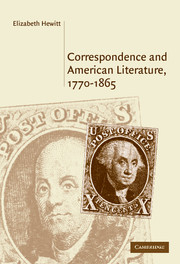1 - National letters
Published online by Cambridge University Press: 22 September 2009
Summary
When Habermas characterizes the eighteenth century as the “century of the letter,” he identifies epistolary writing as the textual apparatus that best represents not only the construction of the privatized individual, but also the bourgeois public sphere that comprises the relations between these autonomous individuals. Letter-writing offers an exemplary case of “audience-oriented privacy,” as well as a template for rational exchange that aims to emancipate itself from any type of domination. As Habermas explains, “Public debate was supposed to transform voluntas into a ratio that in the public competition of private arguments came into being as the consensus about what was practically necessary in the interest of all.” The rational consent that emerges from and in the public sphere demands a reconciliation between public and private interests, and Habermas identifies the letter as the textual form that best realizes this reconciliation.
We can see similar political work in one of the first documents of American national consolidation, the Articles of Confederation, which declares its participants to be in a “firm league of friendship with each other,” thereby insisting on private relations as the model by which to describe the political relations between the various states. Urging ratification of the Articles, one constituent writes, “when any Sociaty Gets Divded in Sentiment it is verry hard to unite them.” The Articles also illustrate the centrality of epistolarity to the formation of the nation, as consolidation is accomplished here by way of a document that takes the form of a letter.
- Type
- Chapter
- Information
- Correspondence and American Literature, 1770–1865 , pp. 16 - 51Publisher: Cambridge University PressPrint publication year: 2004

